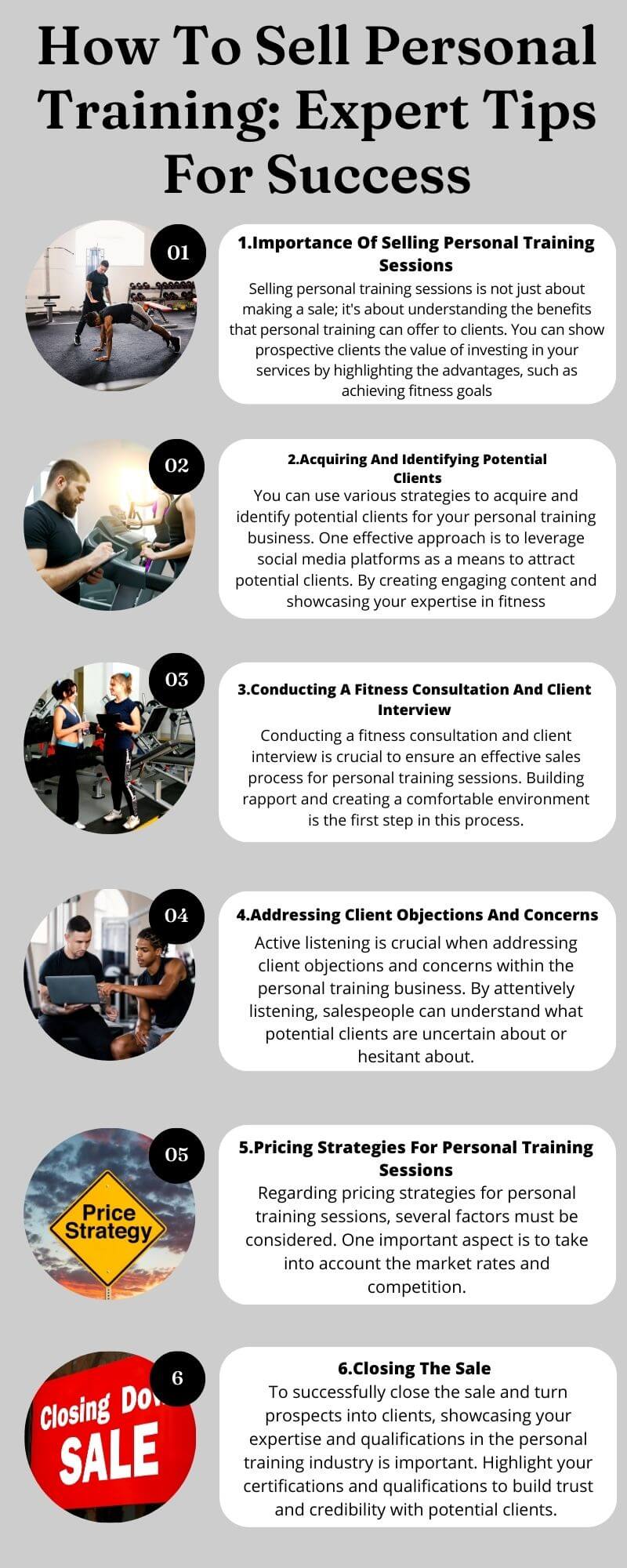Are you a personal trainer looking to enhance your sales skills? Selling personal training sessions is integral to your business and can be challenging for many trainers. However, with the right approach, selling sessions can become more comfortable and more effective. In this blog post, we will discuss a step-by-step guide on how to sell personal training sessions effectively. From understanding the importance of selling sessions to acquiring potential clients, conducting consultations and interviews, addressing client objections and concerns, pricing strategies, closing sales, retaining existing clients, following up with prospects, navigating through challenges, and exploring innovative approaches – we’ve got you covered! By the end of this post, you will have all the knowledge and tools necessary to boost your sales skills and grow your personal training business.
1. Understanding The Importance Of Selling Personal Training Sessions
Selling personal training sessions is not just about making a sale; it’s about understanding the benefits that personal training can offer to clients. You can show prospective clients the value of investing in your services by highlighting the advantages, such as achieving fitness goals, personalized guidance, and accountability. Additionally, discussing how personal training can accelerate progress, prevent injury, and keep clients motivated and committed can further emphasize the importance of selling personal training. Furthermore, mentioning the potential for long-term success and lifestyle changes can help clients see personal training as a transformative experience. Understanding the significance of selling personal training sessions is crucial for any salesperson in the personal training business.
The Role Of A Personal Trainer In The Fitness Journey
In the fitness journey, a personal trainer plays a crucial role by offering expert guidance and support to clients. They go beyond simply creating workout programs; they customize them based on individual needs. Additionally, they provide valuable nutritional advice that complements exercise routines, ensuring a holistic approach to fitness. Personal trainers closely monitor progress and make necessary adjustments to the programs to maximize results. Their motivation and inspiration push clients to reach their fitness goals. By incorporating NLP terms such as “personal training sessions” and “personal training business,” the content effectively highlights the importance of a personal trainer in helping individuals achieve their desired fitness outcomes.

2. Acquiring And Identifying Potential Clients
You can use various strategies to acquire and identify potential clients for your personal training business. One effective approach is to leverage social media platforms as a means to attract potential clients. By creating engaging content and showcasing your expertise in fitness, you can capture the attention of individuals seeking personal training sessions. Additionally, offering a free consultation is a great way to showcase your services and establish yourself as a credible and knowledgeable trainer. Developing partnerships with local businesses can also be beneficial, as they can provide referrals to potential clients. Another tactic is email marketing to reach prospective clients, providing them with valuable information and enticing offers. Lastly, attending fitness events and networking with individuals who could benefit from personal training can help expand your client base.
Techniques For Attracting New Clients
To attract new clients to your personal training business, it’s important to use effective techniques that showcase your expertise and highlight the value you offer. One technique is offering a free trial session, allowing prospective clients to experience your training style firsthand. Compelling testimonials and success stories can also be powerful tools for attracting new clients, as they demonstrate the results you’ve helped others achieve. Providing valuable content through blog posts and social media positions you as an authority in the fitness industry and gives potential clients a taste of your knowledge and expertise. Additionally, offering specialized training packages that cater to specific client needs can help you target a niche market. Finally, implementing a referral program with incentives for clients who refer others to your services can be a great way to leverage the power of word-of-mouth marketing.
3. Conducting A Fitness Consultation And Client Interview
Conducting a fitness consultation and client interview is crucial to ensure an effective sales process for personal training sessions. Building rapport and creating a comfortable environment is the first step in this process. A salesperson can gain valuable insight into the prospective client’s mindset by asking open-ended questions, such as understanding the client’s fitness goals and challenges. Assessing the client’s current fitness level and any medical considerations is important to tailor a personalized training program. Discussing the client’s availability and commitment to training helps determine the best way to structure personal training packages. A fitness business can use the information gathered to create a customized plan that aligns with the prospect’s goals and addresses their needs. This not only provides the prospective client with a reference point but also demonstrates the expertise and professionalism of the personal trainer. Finally, ending the consultation by discussing the next step, whether scheduling their first personal training session or addressing any remaining concerns or objections, sets the stage for a smooth transition into becoming a new client.

Key Questions To Ask Potential Clients
When it comes to selling personal training sessions effectively, asking the right questions to potential clients is crucial. By understanding their specific fitness goals and desired outcomes, you can tailor your approach and highlight the benefits of your personal training packages that align with their needs. It’s also important to inquire about their previous experience with personal training, as this will give you insights into their expectations and provide an opportunity to address any concerns they may have. In addition, asking about any health conditions or injuries that may affect their training will help you design a safe and effective program. Furthermore, determining their availability for training sessions and their preferred training style or exercise routine will allow you to create a personalized plan that suits them best. By asking these key questions, you can demonstrate that you genuinely care about their well-being and increase the likelihood of converting them into satisfied personal training clients.
4. Addressing Client Objections And Concerns
Active listening is crucial when addressing client objections and concerns within the personal training business. By attentively listening, salespeople can understand what potential clients are uncertain about or hesitant about. Clear and concise answers that directly respond to these objections should be provided, accompanied by testimonials and success stories that reinforce the value and benefits of personal training. It’s important to empathize with clients’ hesitations and explain how personal training can address their specific concerns. By focusing on the end goal and highlighting the positive outcomes that can be achieved through personalized fitness sessions, salespeople can effectively alleviate doubts and encourage prospective clients to take the next step.
Common Objections And How To Overcome Them
Overcoming objections is a crucial part of selling personal training packages. One common objection is the lack of time for personal training sessions. However, it’s important to highlight the flexibility in session scheduling and the time-saving benefits of efficiency. Another objection is the perceived expense of personal training. To address this, emphasize the long-term benefits of investing in one’s health and offer flexible payment options. Some potential clients may believe they can achieve their fitness goals independently. Explaining the added value of personalized guidance and accountability that a personal trainer can provide is essential. If a prospect feels they aren’t physically fit enough for personal training, reassure them that it’s suitable for all fitness levels and can be tailored to their needs. Lastly, address the concern of not seeing results by providing examples of previous client success stories and explaining how progress is tracked and measured.

5. Pricing Strategies For Personal Training Sessions
Regarding pricing strategies for personal training sessions, several factors must be considered. One important aspect is to take into account the market rates and competition. By understanding what others are charging, you can position your prices competitively. Additionally, offering different pricing options like personal training packages or monthly memberships can attract a wider range of clients.
Another key factor is to adjust prices based on demand. If there is a high demand for your services, you can increase your prices accordingly. Conversely, offering introductory rates or discounts for new clients to attract them to your personal training business during slower periods.
Continually evaluating and adjusting your pricing strategies is crucial. It’s important to listen to client feedback and stay updated on market trends to ensure your prices remain competitive and aligned with the expectations of your ideal clients. By carefully considering these pricing strategies, you can effectively sell your personal training sessions to prospective clients.
Factors To Consider When Setting Prices
Several factors must be considered when determining the prices for your personal training services. First and foremost, your level of expertise, certifications, and experience significantly determine your pricing. Clients are more likely to pay a premium for a highly qualified and experienced personal trainer.
Next, you should consider the quality and exclusivity of your services. You can justify charging higher prices by offering specialized training programs or personalized attention. Additionally, consider the overhead expenses associated with running your personal training business, such as equipment costs and facility fees.
Furthermore, it’s important to consider the local market demand for personal training services. If there is high demand and limited competition, you can charge higher prices. Lastly, the perceived value and benefits that clients will receive from your services should also be factored in when setting prices. Showcasing the unique value proposition and highlighting the positive outcomes clients can expect will help justify your pricing.
6. Closing The Sale: How To Turn Prospects Into Clients
To successfully close the sale and turn prospects into clients, showcasing your expertise and qualifications in the personal training industry is important. Highlight your certifications and qualifications to build trust and credibility with potential clients. Another effective strategy is offering personalized training programs tailored to each client’s specific needs and goals. You demonstrate your commitment to helping them achieve their fitness objectives by providing personalized solutions. Additionally, offering free trials or consultations can be a great way to showcase the value of your services and allow prospects to experience firsthand what you have to offer. Utilizing social media platforms to share success stories and testimonials is also crucial in building trust and attracting potential clients. Lastly, communication of clear pricing and package options ensures transparency and helps prospects make informed decisions.

Effective Strategies For Closing The Sale
Building rapport with potential clients through personalized interactions is crucial to close a sale in the personal training business. You can overcome any barriers hindering their decision-making by addressing their objections or concerns about personal training and offering flexible training sessions to accommodate their busy schedules. Providing information on the benefits of personal training, such as weight loss and improved fitness, can also help solidify their interest. Additionally, following up with potential clients through email or phone is a great way to keep the conversation going and demonstrate your commitment to their success. Effective communication and a genuine understanding of their needs are the keys to converting prospects into satisfied clients.
7. Retaining Your Existing Client Base
To maintain a loyal client base, you must regularly assess your client’s goals and motivations. By understanding their objectives, you can tailor your personal training packages to meet their needs and keep them motivated. Additionally, offering nutrition guidance and meal plans is a great way to support their fitness journey and provide them with holistic care. To ensure client satisfaction, offer ongoing support and encouragement beyond personal training sessions. Continuously updating and varying their exercise routines will keep them engaged and excited about their fitness journey. Lastly, consider offering rewards or incentives for client loyalty, such as discounted sessions or referral bonuses.
Tips For Maintaining Client Satisfaction And Loyalty
To ensure client satisfaction and loyalty in the personal training business, it is important to check in regularly with clients, tracking their progress and addressing any concerns they may have. Another key aspect is providing various training options, such as in-person or virtual training, to cater to different preferences and circumstances. Additionally, incorporating new and innovative exercises or techniques into their workouts keeps clients engaged and excited about their fitness journey. Offering personalized challenges and goal-setting helps to keep clients motivated and focused on their desired outcomes. Finally, creating a sense of community by organizing group fitness activities or workshops fosters a supportive environment and enhances the overall client experience.

8. How To Effectively Follow Up With Potential Clients?
To effectively follow up with potential clients, personalize your emails to highlight the unique benefits of personal training. Offer incentives or discounts for signing up within a specific timeframe. Schedule phone calls or meetings to address concerns and share satisfied clients’ testimonials. Stay consistent to stay top-of-mind.
9. Navigating Through Challenges In Selling Personal Training Sessions
Minimizing client cancellations or no-shows is crucial for the success of your personal training business. One effective strategy is implementing a cancellation policy that clearly outlines the consequences for missed sessions. Addressing common objections or concerns like pricing and time commitment is another way to navigate challenges in selling personal training sessions. Providing references or case studies can help alleviate potential clients’ doubts about your services. Staying informed about industry trends and advancements showcases your expertise and credibility. Additionally, continuously improving your sales skills through training and education will enhance your ability to sell personal training packages successfully.
Dealing With Client Cancellations Or No-Shows
Dealing with client cancellations or no-shows can be challenging when it comes to personal training. To address this issue, it’s important to set clear expectations and communicate the importance of consistency and commitment. One way to minimize cancellations is by implementing reminder systems, such as automated text or email reminders, to help clients stay on track. Additionally, offering flexible rescheduling options can accommodate unforeseen circumstances and make it easier for clients to find alternative times for their sessions. Providing incentives for clients who consistently attend their scheduled sessions can also motivate them to prioritize their fitness journey. Finally, using client feedback to identify and address potential issues proactively can help improve client satisfaction and reduce cancellations or no-shows in the future.
Conclusion
Selling personal training sessions requires a combination of knowledge, skill, and effective communication. It is important to understand the value of personal training and how it can positively impact clients’ fitness journey. To acquire and identify potential clients, you need to utilize techniques that attract and engage them. Conducting a fitness consultation and client interview allows you to gather important information and tailor your approach to each individual. Addressing client objections and concerns is crucial in building trust and overcoming any barriers they may have. Regarding pricing, consider various factors such as your expertise, location, and competition. Closing the sale requires effective strategies and personalized recommendations. Retaining your existing client base involves maintaining their satisfaction and loyalty. Finally, don’t forget the importance of following up with potential clients and consistently navigating through challenges in this industry.


